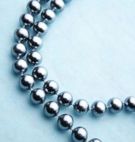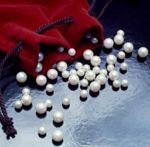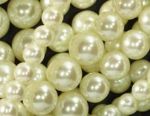Pearl
From Giftypedia
The pearl an organic gem produced in the soft tissue of a living shelled mullosk.
[edit] What is a Pearl?
pearl purl - A gem formed in mollusk: a small lustrous sphere of calcium carbonate that forms around a grain of sand in an ocean organism such as an oyster.
Most pearls sold today are cultured (man made). Natural occurring pearls are very rare.
Pearl comes form the Latin word literally meaning "unique", attesting to the fact that no two pearls are identical.
Pearls are very soft and range between 2.5 and 4.5 an the Mohs scale.
[edit] Occasions for Giving the Gift of Pearls
Pearl is the birthstone of June.
Pearls are the gift for the modern 12th wedding anniversary.
Mary Queen of Scots, was given a large collection called the Hanoverian Pearls on her wedding day.
Pearls are a perfect engagement gift.
Pearls make a classic gift for a June bride. They also make a wonderful presentation for the Mother of the Bride and bridesmaids.
Pearls aren't just for grown-ups. A tiny pearl bracelet or jewelry set makes a wonderful keepsake gift for a Flower Girl.
Pearls are often given as a Baptism or Confirmation gift.
Sweet 16 Birthday is an excellent time for a pearl necklace or earrings.
[edit] When to Wear Pearls
Since ancient times, pearls have been a symbol of perfection. Cleopatra was said to wear pearls.
Many brides still choose pearls to wear on their wedding day.
Pearls are a versatile addition to any wardrobe. The can be worn with your favorite jeans or with your fanciest dinner dress.
Black pearls have a quiet dignity and can be worn where white peals would be considered too flashy, such as funerals or formal dinners, although they are not limited to these occasions.
[edit] The History of Pearls
In 1893, Kokichi Mikimoto succeeded in producing the world's first cultured pearl.[1]
In ancient times, the pearl has been a symbol of unblemished perfection. In classical Rome, only persons above a certain rank were allowed to wear pearl jewelry.
In Islam, the Koran often mentions that dwellers of paradise will be adorned with pearls.
In Hindu religion the presentation of an undrilled pearl and its piercing has formed part of the marriage ceremony.
[edit] Types of Pearls
- Cultured - A specific technique used in Japan for inducing the creation of a round pearl within an oyster. Kokich Mikimoto was the first to successfully use this technique, developed by William Sawville-Kent.
- Natural - Very rare, formed randomly and are accidents of nature.
- Freshwater - Formed in lakes, rivers, ponds and other freshwater bodies in mainly in China. Japan and the U.S. also produce these types. Freshwater pearls come in a variety of pastel shades.
- Saltwater - Lustrous and attractive, these pearls are harvested in smaller numbers that other pearls.
Akoya - Produced by Akoya oysters in Japan. Known for their high luster and rich color.
South Sea - Large pearls, most more than 10mm, produced by much larger oysters in the warm waters of the South Seas, in Australia, Indonesia and the Philippines.
Tahitian Pearl - Grown in the Black Lipped Oyster found throughout its native waters of French Polynesia. Known for their dark color.
Conch Pearl - Natural pearls harvested from Queen conch, which lives in the Caribbean and the Gulf of Mexico. They contain no nacre, so technically they are not actually pearls at all. Characterized by a distinctive 'flame structure' that gives the appearance of a fire burning on the surface.
Mabe Pearl - A hemispherical shaped pearl which is grown against the inside of the oyster's shell, rather than within its tissue. Mabes occasionally appear in nature. [2]
Abalone Pearl - Some of the rarest pearls, abalone has an intense luster and a mixed color palette of blues, lavender, orange, green, pink and silver.
[edit] Qualities of a Pearl
There are four grades for pearls, AAA being the highest quality: A, A+, AA and AAA. The two key factors that determine the grade are:
- Luster
- Surface Perfection
The other factors that determine quality are:
- Color
- Shape
- Size
[edit] How to Care for Your Pearls
- Daily Care for Your Pearls - Put on your pearls after applying makeup. Wipe them with a soft cloth after wearing to remove any makeup or perfume residue.
- Storage for Your Peals - Make sure all clasps and pins are fastened and secure and lay them out separately so that they do not rub against each other.
- Cleaning Your Pearls - The safest thing to do is to take your pearls to a specialist. Never place pearls in an ultrasonic cleanser or use any chemicals to attempt to clean your pearls as these methods could damage their luster.
[edit] Related Items
[edit] References







 Printer Friendly
Printer Friendly
